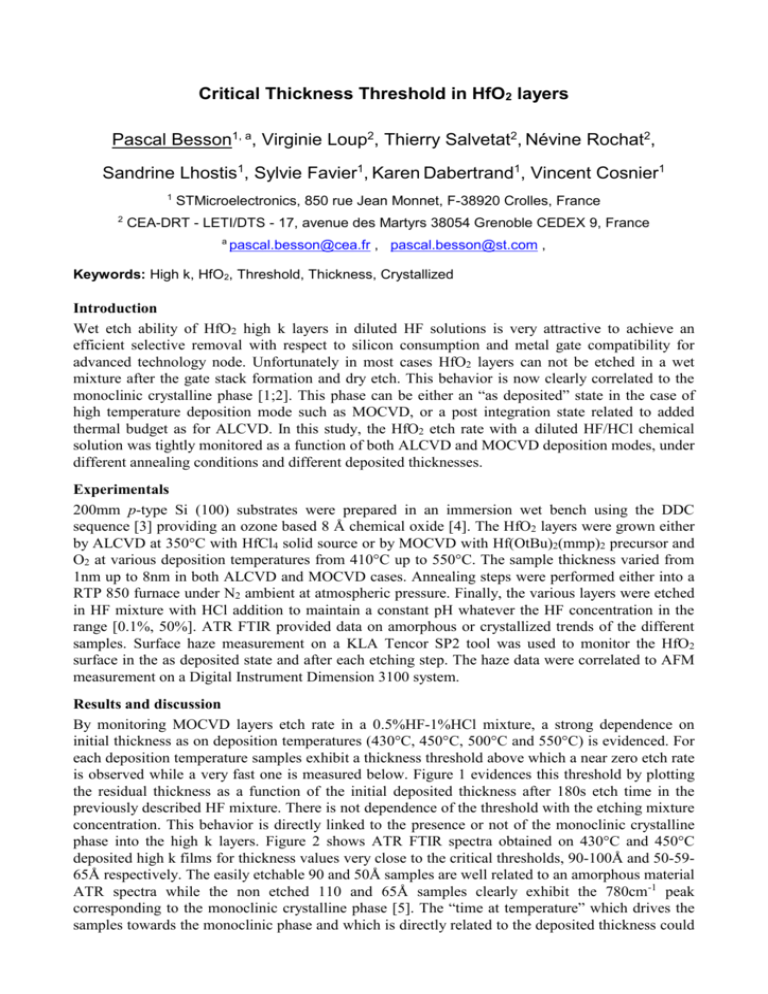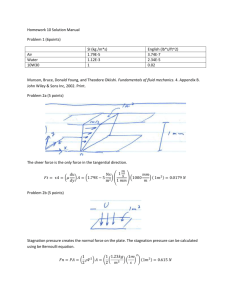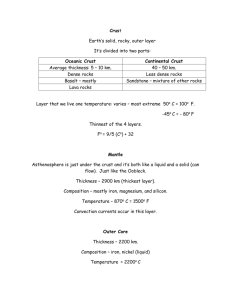Your Paper`s Title Starts Here:
advertisement

Critical Thickness Threshold in HfO2 layers Pascal Besson1, a, Virginie Loup2, Thierry Salvetat2, Névine Rochat2, Sandrine Lhostis1, Sylvie Favier1, Karen Dabertrand1, Vincent Cosnier1 1 2 STMicroelectronics, 850 rue Jean Monnet, F-38920 Crolles, France CEA-DRT - LETI/DTS - 17, avenue des Martyrs 38054 Grenoble CEDEX 9, France a pascal.besson@cea.fr , pascal.besson@st.com , Keywords: High k, HfO2, Threshold, Thickness, Crystallized Introduction Wet etch ability of HfO2 high k layers in diluted HF solutions is very attractive to achieve an efficient selective removal with respect to silicon consumption and metal gate compatibility for advanced technology node. Unfortunately in most cases HfO2 layers can not be etched in a wet mixture after the gate stack formation and dry etch. This behavior is now clearly correlated to the monoclinic crystalline phase [1;2]. This phase can be either an “as deposited” state in the case of high temperature deposition mode such as MOCVD, or a post integration state related to added thermal budget as for ALCVD. In this study, the HfO2 etch rate with a diluted HF/HCl chemical solution was tightly monitored as a function of both ALCVD and MOCVD deposition modes, under different annealing conditions and different deposited thicknesses. Experimentals 200mm p-type Si (100) substrates were prepared in an immersion wet bench using the DDC sequence [3] providing an ozone based 8 Å chemical oxide [4]. The HfO2 layers were grown either by ALCVD at 350°C with HfCl4 solid source or by MOCVD with Hf(OtBu)2(mmp)2 precursor and O2 at various deposition temperatures from 410°C up to 550°C. The sample thickness varied from 1nm up to 8nm in both ALCVD and MOCVD cases. Annealing steps were performed either into a RTP 850 furnace under N2 ambient at atmospheric pressure. Finally, the various layers were etched in HF mixture with HCl addition to maintain a constant pH whatever the HF concentration in the range [0.1%, 50%]. ATR FTIR provided data on amorphous or crystallized trends of the different samples. Surface haze measurement on a KLA Tencor SP2 tool was used to monitor the HfO2 surface in the as deposited state and after each etching step. The haze data were correlated to AFM measurement on a Digital Instrument Dimension 3100 system. Results and discussion By monitoring MOCVD layers etch rate in a 0.5%HF-1%HCl mixture, a strong dependence on initial thickness as on deposition temperatures (430°C, 450°C, 500°C and 550°C) is evidenced. For each deposition temperature samples exhibit a thickness threshold above which a near zero etch rate is observed while a very fast one is measured below. Figure 1 evidences this threshold by plotting the residual thickness as a function of the initial deposited thickness after 180s etch time in the previously described HF mixture. There is not dependence of the threshold with the etching mixture concentration. This behavior is directly linked to the presence or not of the monoclinic crystalline phase into the high k layers. Figure 2 shows ATR FTIR spectra obtained on 430°C and 450°C deposited high k films for thickness values very close to the critical thresholds, 90-100Å and 50-5965Å respectively. The easily etchable 90 and 50Å samples are well related to an amorphous material ATR spectra while the non etched 110 and 65Å samples clearly exhibit the 780cm-1 peak corresponding to the monoclinic crystalline phase [5]. The “time at temperature” which drives the samples towards the monoclinic phase and which is directly related to the deposited thickness could be proposed as a simple explanation for the thickness threshold in MOCVD layers. Nevertheless, by monitoring the etch rate on a single 550°C MOCVD wafer with a non uniform initial thickness in the range [35Å, 40Å] the threshold is also evidenced. Indeed on such wafer surface the wet etch results in a phobic state in the 35Å center area while the edge area still presents the initial 40Å film. In this case the wafer received the same process time at 550°C, the initial non uniformity has been explained by a flow effect. Regarding ALCVD HfO2 data on figure 3, the “as deposited” 350°C samples present high etch rates whatever the initial thickness is, when up to 8nm where the crystallization begins avoiding a full layer removal. Nevertheless, after a 600°C 15min anneal the same initial deposited thickness dependence than previously seen on MOCVD is exhibited with a threshold at 28Å. No etch occurs above while below it etch rates are a little bit lower than on “as deposited” layers. Here again, obviously no deposition thermal effect can be considered between a 28 and 30Å samples. The behavior is more related to the crystallization onset after 600°C anneal. High k Threshold 430°C 100Å MOCVD 450°C 500°C 60Å 45Å 550°C 38Å As Dep 80Å ALCVD 350°C 600°C 15min N2 Atm 28Å Table I: critical thickness threshold measured by ellipsometry for different HfO2 types The wet etch rate measurement demonstrates a relevant information about high k layer state: mainly the existence of a critical thickness threshold at which the monoclinic phase transition occurs, as presented in table 1. However, the unique thickness decrease monitored by ellipsometry can not provide a full characterization of the high k layer removal, especially for samples just below this critical threshold. This is a major issue as the high k thickness integrated for a suitable EOT in an advanced CMOS process flow is mainly in the 20 to 30Å range. Indeed, these values are very close to the 28 and 38Å thickness thresholds observed for annealed ALCVD and MOCVD 550°C samples respectively. Focusing on a restricted thickness range around the threshold, ATR FTIR characterization is performed in parallel with the thickness measurement after 7min30sec and 15min etch time in a 0.1%HF/HCl mixture. Figure 4 shows the HfO2 peak evolution as a function of its thickness. Initially, only the wafer A with 41Å high k layer exhibits a clear monoclinic crystalline trend with two well define adsorption bands at 780cm-1 and 675cm-1. Wafers B and C with 36 and 31Å respectively present a similar large and poorly defined peak relative to an amorphous structure. After the etch steps, the wafer A spectrum remains unchanged confirming the stable thickness value. The HfO2 peak intensity of wafers B and C decrease in line with the thickness loss. Nevertheless, when the residual thickness values reach 9Å from 36Å initial thickness, the two peaks of the monoclinic phase appear again on the FTIR spectra while the SiO2 peak shifts from 1228 to 1213 cm-1. Moreover, on the wafer C the SiO2 peak of the oxide under-layer disappears but a small peak at 675cm-1 seems always present. As the HfO2 monoclinic phase is not sensitive to HF mixture at room temperature, some crystallized residues stay on the surface. For these HfO2 layers below the critical threshold, the surface residues could be considered as part of crystallized HfO2 initially embedded in an amorphous matrix. Using TXRF the residual hafnium atoms concentrations on the surface of wafers A, B and C are: 2.5E14, 1.4E14 and 1.75E13 for residual thicknesses of 41, 9 and 0Å respectively. Far from ellipsometric values FTIR and TXRF data suppose a large amount of residual HfO2 on the surface expected as being in crystallized structure. AFM measurements reveal a smooth high k surface on wafer A. But wafer B exhibits a very huge roughness as if the residual crystallized HfO2 was under columnar form with a height equivalent to the nominal deposited thickness. Investigating the other high k types the strong dependence of the residual hafnium surface concentration with the initial deposited thickness is verified in figure 5. When the initial thickness is lower than 20Å the residual hafnium surface concentration is lower than the Low Limit Detection of the TXRF (LLD value = 2.45E10 at/cm²). From 20Å to the critical threshold the residual hafnium concentration always appears to be high and more correlated to the initial deposited thickness than the residual thickness, even when the monitored residual thickness is equal to 0. For initial deposited thicknesses very close to the critical threshold, the ellipsometric data can present within a same wafer different values from 0 to few Å (<10Å) correlated with the nominal thickness range (<2Å). In these cases AFM pictures in table II always evidence the columnar aspect with just a little change in residues density depending on the residual value. ALCVD “As dep” Initial Thickness = 80Å Initial Thickness = 82Å Residual Thickness 0Å Residual Thickness = 5Å MOCVD 450°C Initial Thickness = 62Å Residual Thickness = 10Å MOCVD 450°C Initial Thickness = 60Å Residual Thickness = 0Å MOCVD 550°C Wafer B Initial Thickness = 35Å Initial Thickness = 36Å Residual Thickness = 0Å Residual Thickness = 5Å Table III: AFM pictures of 3 HfO2 types just below the critical threshold after etch and range on a same wafer/each type Based on all these results the behavior of high k layers around the critical thickness threshold can be summarized as follow: The layers can be etched with HF solutions but the etch rate is strongly impacted by the crystallized compounds density. The crystallized compounds density increases linearly with the initial deposited thickness up to a critical threshold where the layer is fully crystallized. The “true” critical threshold can be higher than the ellipsometric one presented previously. Indeed a small part of amorphous HfO2 can be still present even if the ellipsometric data remain stable after a wet etch. This point can be suspected by using the haze measurement on a SP2 tool on wafers just around the ellipsometric threshold. Figure 6 presents the haze intensity as a function of the etch time and the residual thickness. Wafer B haze evolution occurs in line with the removal of the amorphous part and the roughness increase seen by AFM. Wafer A with only 2Å loss reveals also a haze increase, not seen by AFM, which could be related to the removal of a small amorphous part between the crystallized structures. For samples with thicknesses more clearly below the threshold, the isolated crystallized parts included inside the amorphous matrix are likely removed by lift-off effect. This may explain the lack of residual hafnium concentration for layers below 20Å as checked by TXRF. Conclusion A specific chemical behavior of HfO2 layers in the 15, 40Å range currently use for CMOS applications is demonstrated. Working on this behavior can help the crystallization mechanism understanding and provide more explanation about the origin of the residues currently seen after the gate etch. References [1] Karen Dabertrand, et al, EMRS-2006, Symposium [2] Shinji Fujii, et al, Applied Physics Letters 86 (2005) [3] F.Tardif, et al, UCPSS, Belgium (1996), p 175. [4] S. Petitdidier, et al, UCPSS, (2002) [5] N.Rochat, et al. Physica Status Solidi (c), 1 (2003) 0,13 160 140 430°C Initial Thickness 450°C After First Etch Step 500°C After Second Etch Step ATR Absorbance [a.u.] Residual Thickness [Å] 0,11 0,1 120 100 0,12 41Å 0,09 0,08 36Å 25Å 550°C 80 0,07 0,06 9Å 0,05 60 31Å 40 0,04 0,03 19Å 0,02 20 0Å 0,01 0 0 0 20 40 60 80 100 120 140 160 1300 1200 1100 900 800 700 600 Wavenumber [cm-1] Initial Thickness [Å] Fig.1. Threshold for different deposition temp. of MOCVD HfO2 layers as a function of initial thickness Fig.4. 550°C MOCVD HfO2 ATR FTIR spectra evolution as a function of the residual thickness 0,25 1,00E+15 50 Hf concentration [at/cm²] 450°C 59Å 0,2 450°C 65Å 0,15 430°C 90Å 430°C 110Å 0,1 0,05 1,00E+14 ALCVD 350°C + 15 min Atm 600°C Anneal 40 SAMPLES ABOVE THRESHOLD ALCVD 350°C As Dep 1,00E+13 30 1,00E+12 20 1,00E+11 10 TXRF LLD 0 1300 1200 1100 1000 900 800 700 1,00E+10 600 0 10 15 -1 Wave number [cm ] 25 30 35 40 3 48 105 2,5 15 y = -0,43x+22 2 R = 0,981 y = -0,28x+26 R2 = 0,992 y = -0,49x+27 R2 = 0,996 y = -0,60x+21,5 R2 = 0,9916 0 45 0 10 20 30 40 50 60 70 80 90 30 y = -0,12x+77 2 R = 0,99 y = -0,23x+49 R2 = 0,98 15 Residual Thickness [Å] 40 90 60 Wf A Wf B Wf C 32 2 1,5 24 - 1 16 0,5 8 0 0 0 100 200 300 50 Fig.5. Hafnium atoms surface concentration as a function of the initial and residual thickness 30 75 45 400 500 600 700 Etched Time [sec] Fig.3. 350°C ALCVD HfO2 etch rate in HF/HCl mixture as a function of the initial thickness. White squares and black triangles are “as dep” and “600°C 15min annealed” respectively 0 200 400 600 800 0 1000 Wet Etch Process Time [min] Fig.6. Haze intensity evolution as a function of etch time and residual thickness Wide Channel Oblique Incidence Haze Intensity [a.u.] Residual Thickness [Å] 20 Initial Deposited Thickness [Å] Fig.2. ATR FTIR spectra of 450°C and 430°C MOCVD HfO2 layers as a function of initial thickness 120 Residual Thickness after HF Etch [Å] MOCVD 550°C 450°C 50Å Absorbance [a.u.] 1000






